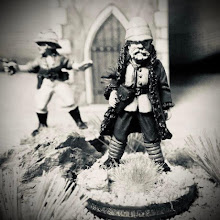Warlord Games Highland Grenadiers painted as the 42nd Highland Regiment.
Another excellent product to fill out my unit for Rebels and Patriots (Paid Link) of the 42nd Highland Regiment is the blister pack of Highland Grenadiers from Warlord games. Four figures come in the pack - and my pack had 3 different variants. Not bad! As with the Line Company Highlanders from Warlord Games, these grenadiers are armed to the teeth with broadswords, dirks and pistols in addition to musket and bayonet. There is controversy as to when the red stripe was added to the Grenadier Company's tartan but I am not going to go down that rabbit hole. I decided to add the red stripe mainly because I think it looks cool. I'm the Colonel, and like in the old days, I paid, er, painted the uniforms!
A grenadier was originally a specialist soldier, first established as a distinct role in the mid-to-late 17th century, for the throwing of grenades
and sometimes assault operations. At that time grenadiers were chosen
from the strongest and largest soldiers. By the 18th century, dedicated
grenade throwing of this sort was no longer relevant, but grenadiers
were still chosen for being the most physically powerful soldiers and
would lead assaults in the field of battle.
The wide hats with broad brims characteristic of infantry during the
late 17th century were discarded and replaced with caps. This was
originally to allow the grenadier to sling his musket over his back
with greater ease while throwing grenades (initially, only these troops
were provided with slings). Additionally, a brimless hat permitted the
grenadier greater ease in throwing the grenade overhand. By 1700,
grenadiers in the English and other armies had adopted a cap in the
shape of a bishop's mitre, usually decorated with the regimental insignia in embroidered cloth.
Grenade usage declined significantly in the early 18th century, a fact
that can be attributed to the improved effectiveness of massive infantry line tactics and flintlock technology. However, the need for elite assault troops
remained, and the existing grenadier companies were used for this
purpose. As noted, above average physical size had been considered
important for the original grenadiers and, in principle, height and
strength remained the basis of selection for these picked companies. In
the British regiments of foot during the 18th century the preference
was, however, to draw on steady veterans for appointment to individual
vacancies in a grenadier company (one of the eight companies comprising
each regiment). On occasion, such as at Louisburg and at Quebec, Grenadier Companies from various regiments might be "brigaded" together to form a larger elite unit.
Another winner from Warlord Games. Now when my flags come in, I'll be able to post the command element and show the whole unit together.







Impressive details on these grenadiers, great job!
ReplyDeleteThanks Phil. As of this posting I have finished my initial British Force and now I have started on the French. The grenadiers were fun to paint and add that extra "umphh" to the overall look of the Highlander Regiment.
DeleteVery nice work, I like the extra detail on the back of the bearskin
ReplyDeleteThanks!
DeleteVery nice work, I like the extra detail on the back of the bearskin
ReplyDeleteDouble the compliment. Thanks again.
DeleteNeil
Beautifully painted Highland Grenadiers, Neil! Love the bearskin and tartan.
ReplyDeleteThanks Dean.
DeleteCrikey, you'd think those guys were 54mm. That's a high quality paint job and nice photography as well.
ReplyDeleteKeith, thank you very much. I’ve been trying to work on my photography so that means a lot.
DeleteNeil